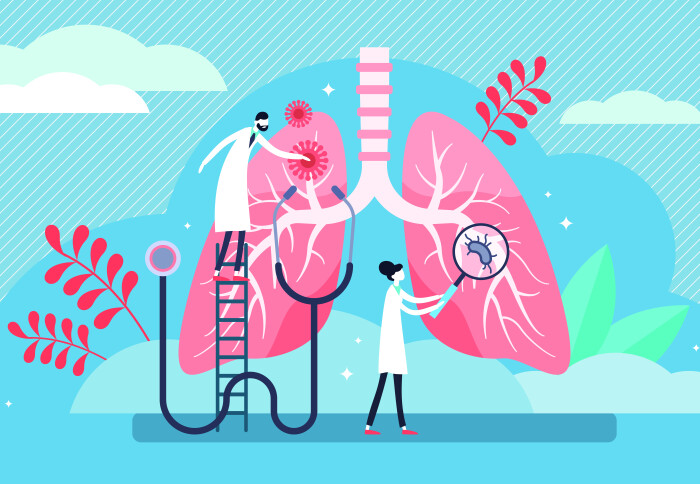Better understanding of lung microbiome opens door for new respiratory treatment

New research on thoracic microbiome of healthy individuals could help treat those with respiratory illnesses.
Professors Miriam Moffatt and Bill Cookson have led a study at the National Heart and Lung Institute to further our knowledge on the bacteria that make up the microbiome in the lungs of healthy individuals. Their study, published in Communications Biology, provides a pathway to develop new treatments for respiratory disease including asthma.
"By growing and sequencing most of the major species of the airway bacteria we have found many unexpected and exciting organisms. The stage is set to investigate each of these for their individual activities in keeping our airways healthy and pathogens at bay" Professors Moffatt and Cookson Lead authors
The internal (mucosal) surfaces of our airways and lungs are extensive and constantly challenged by inhaled microorganisms. Respiratory infections are consequently the leading cause of death in developing countries, resulting in 4 million deaths annually. Asthma and chronic obstructive pulmonary disease (COPD) each affect more than 300 million people worldwide. Acute attacks (exacerbations) of both diseases are driven by infection.
The airways of healthy lungs are accompanied by a community of bacteria known as the commensal microbiome. Unlike their cousins in the gut, bacteria in the lungs are free of the task of digesting nutrients, and they play major parts in resisting infection and regulating immunity. Different from the healthy gut bacteria, those in the lung have been poorly studied and the roles of different species in maintaining health remain to be discovered.
An unwanted effect of advancing civilisation is that the microbiome loses its natural diversity, and bad bacteria (pathogens) increase in number. This condition is known as dysbiosis. Airway dysbiosis is a factor in many respiratory diseases, particularly asthma and COPD.
Professors Moffatt and Cookson and their collaborators wanted to find out what causes dysbiosis and how it can be prevented or recovered from. To do this they set about capturing the microbiome of healthy people to see what could be learned.
Unchartered territory
This paper describes the systematic culture of bacteria gathered from the airways deep within the lung during bronchoscopy. It discovered 52 novel species amongst 126 organisms covering three quarters of the abundance of airway commensals. Analysis of all the genetic sequences of these bacteria was combined with gene expression and metabolomic data from respiratory epithelium and provided many completely new insights into the interactions between us (the hosts) and our respiratory microbiome.
The findings of this study substantially add to what is known about individual airway bacteria and how they work in communities. Genome sequencing of the different bacteria found many clinically relevant genes, for example new sequences encoding antimicrobial synthesis, adhesion to the airways, and immune modulation.
The researchers identified dysbiotic features that may allow pathogens to grow and influence asthma and COPD. They also identified pathways that sustain healthy interactions between commensals and the lung mucosa. The results of this work provide a systematic basis for decrypting interactions between commensals, pathogens, and mucosa.
Exciting new horizons
Treatments derived from healthy microbial communities are already established for inflammatory and metabolic bowel diseases, such as through faecal transplantation, administration of particular commensals, or dietary changes. This new research provides reason to believe this same concept could be applied in the lungs. The systematic collection of cultured and genetically sequenced healthy airway bacteria provided us with the exciting potential to develop microbial therapies for common respiratory diseases.
Professorss Moffatt and Cookson said "We are very pleased that this work has been published in such a good journal, because it represents a huge amount of work by many wonderful collaborators in different parts of the world. The bacteria that live in us and on us are known as the microbiome. They are essential for human health. It is commonplace for people to talk about "the microbiome" as a single entity, but that is like describing the immune system as "white cells". By growing and sequencing most of the major species of the airway bacteria we have found many unexpected and exciting organisms. The stage is set to investigate each of these for their individual activities in keeping our airways healthy and pathogens at bay".
The paper shows how continued research into the respiratory microbiome is crucial to provide treatments for the hundreds of millions of people worldwide effected by respiratory conditions.
‘Genomic attributes of airway commensal bacteria and mucosa’ by William Cookson, Miriam Moffatt, et al. is published in Communications Biology. DOI: https://doi.org/10.1038/s42003-024-05840-3
Article supporters
Article text (excluding photos or graphics) © Imperial College London.
Photos and graphics subject to third party copyright used with permission or © Imperial College London.
Reporter
Ms Helen Johnson
Communications Division